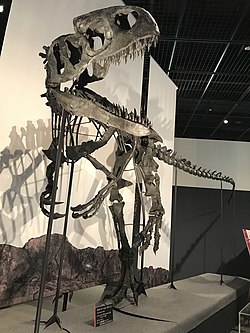Neovenator
| Neovenator Temporal range: Early Cretaceous
| |
|---|---|

| |
| Restoration of Neovenator | |
| Scientific classification | |
| Kingdom: | |
| Phylum: | |
| Class: | |
| Superorder: | |
| Order: | |
| Suborder: | |
| Superfamily: | |
| Family: | |
| Genus: | Neovenator |
| Species | |
|
N. salerii Hutt, Martill, & Barker, 1996 (type) | |
Neovenator ("New-Hunter") is a genus of allosauroid dinosaur. Since its discovery on the Isle of Wight, UK, it has become one of the best-known large carnivorous dinosaurs in Europe. Neovenator was at first considered possibly a new species of Megalosaurus. It measured approximately 7.5 meters in length, and was of a gracile build. It lived during the Barremian stage of the Cretaceous Period.
Discovery and species
The first bones of the type species were discovered in 1978, in the chalk cliffs of southwest Isle of Wight. It was much later (1996) that more bones from this specimen were found. Excavations undertaken by Dr Steve Hutt and his team have so far revealed approximately 70% of the skeleton.
At the time that it was described, by Steve Hutt, Martill and Barker in 1996, it was considered the only known allosaurid in Europe. However, further studies suggested it had more in common with the advanced carcharodontosaurid group of allosaurs, and several studies including a detailed examiniation of the species by Brusatte, Benson and Hutt in 2009 showed that it is in fact the most primitive member of the Carcharodontosauridae.[1]
References
- ^ Brusatte, S.L., Benson, R.B.J., and Hutt, S. (2008). "The osteology of Neovenator salerii (Dinosauria: Theropoda) from the Wealden Group (Barremian) of the Isle of Wight." Monograph of the Palaeontographical Society, 162(631): 1-166.
External links
